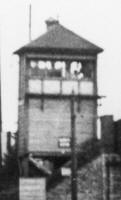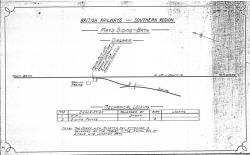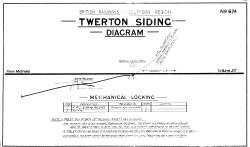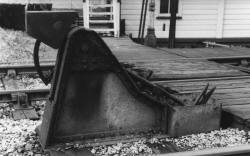 |
Somerset &
Dorset Joint Railway Signalling at Bath Junction and Bath Ticket Platform |
 |
||||||||
|
||||||||||
|
||||||||||
Bath Junction was located at the northern end of the main line of the Somerset & Dorset Joint Railway (S&DJR), on the section northwards from Evercreech Junction in the county of Somerset which was known historically as the 'Bath Extension'. On 20-July-1874 the Somerset and Dorset Railway (S&DR) opened its 'Bath Extension' from Evercreech Junction to Bath, where it joined the 'Bath Branch' of the Midland Railway (MR) a short distance to the west of that company's station at Bath. The S&DR became the S&DJR in 1875 when the line was leased jointly by the MR and the London & South Western Railway (L&SWR). After the Grouping of the railways of Great Britain in 1923 the S&DJR became a Joint line under the control of the London, Midland & Scottish Railway (LMS) and the Southern Railway (SR), who were the successors to the MR and L&SWR respectively. When the railways were nationalised in 1948 the Joint line came under the control of British Railways (Southern Region) (BR(SR)), but in due course control of the Bath Extension section passed to British Railways (Western Region) (BR(WR)) until the line closed on 6-March-1966.

Bath Junction signal-box viewed from the S&DJR side in August 1965
On 4-August-1869 the Midland Railway opened a double-track branch line from Mangotsfield (on its main line from Birmingham to Bristol) to a terminus at Bath. This line approached Bath from the north-west and entered the station on a roughly west-east alignment. The new Bath station was known unofficially as Bath Queen Square, but it was renamed Bath Green Park in 1951. (Note: this is not the same Bath station as the one constructed by the Great Western Railway on their own line through Bath and which is known now as Bath Spa). When the S&DJR reached Bath in 1874 it joined the MR line at Bath Junction, about 40 chains from the buffer-stops at the terminus, with a junction which faced trains leaving the station. The junction itself was double-track, but the S&DJR lines converged into single-track within a few yards of the divergence. The S&DJR line swung away towards the south-west and curved through almost 180° as it climbed out of Bath on its way towards Midford and eventually Evercreech Junction. The MR provided two signal-boxes at Bath: Bath Station, which controlled the station area (and also access to the locomotive sheds and goods yard) and Bath Junction, which controlled the actual junction (and access to additional sidings). The latter box was located on the north side of the MR line, a short distance on the Mangotsfield side of the junction, but in 1911 it was replaced by a new box some distance on the Bath side of the junction.
In 1876 the double-to-single line points at the start of the S&DJR single-track line were moved further out to a location about 11 chains from the junction, creating a short section of double-track at the start of the S&DR line. (This work was done to facilitate the relocation of the 'Bath Ticket Platform' as described here.) A new Bath Single Line Junction signal-box was opened on 5-November-1876 next to the relocated points, presumably as they were now too far away to be worked mechanically from Bath Junction signal-box. It is believed that the signal-box at Bath Ticket Platform was closed at the same time.
 There is not a great deal of
available information about the new signal-box, which was built by the MR at the cost of the S&DJR.
There are references in the Minutes of the S&DJR Officers meetings that the MR
subsequently maintained and manned the signal-box at the expense of the
S&DJR. The signal-box was sited on the Up side of the S&DJR line, on top of the embankment
just to the north of Bridge 1, where the line crossed over the Lower Bristol
Road and Bellotts Road on a curved viaduct of girders and brick arches. Although there are several photographs of
S&DJR trains in that area in the early 1900s the signal-box does not appear
in any of them, but fortunately there is one surviving view of its south end taken from the nearby road which shows that it was an
all-timber structure of the MR Type 1 design (click picture for
larger image). It is probable, but not proven, that it was fitted with a lever-frame of a contemporary MR
design and there is an unsubstantiated claim that there were 8 levers
(including some spares). Although the precise installation is not known, it
is probable that the signalling consisted simply of the facing
points and associated Facing Point Lock, Up Home and Up Distant
signals, and Down Home and Down Distant signals.
There is not a great deal of
available information about the new signal-box, which was built by the MR at the cost of the S&DJR.
There are references in the Minutes of the S&DJR Officers meetings that the MR
subsequently maintained and manned the signal-box at the expense of the
S&DJR. The signal-box was sited on the Up side of the S&DJR line, on top of the embankment
just to the north of Bridge 1, where the line crossed over the Lower Bristol
Road and Bellotts Road on a curved viaduct of girders and brick arches. Although there are several photographs of
S&DJR trains in that area in the early 1900s the signal-box does not appear
in any of them, but fortunately there is one surviving view of its south end taken from the nearby road which shows that it was an
all-timber structure of the MR Type 1 design (click picture for
larger image). It is probable, but not proven, that it was fitted with a lever-frame of a contemporary MR
design and there is an unsubstantiated claim that there were 8 levers
(including some spares). Although the precise installation is not known, it
is probable that the signalling consisted simply of the facing
points and associated Facing Point Lock, Up Home and Up Distant
signals, and Down Home and Down Distant signals.

Conjectural signal diagram for Bath Single Line Junction
When the Bath Extension was opened in 1874 the block working on S&DJR single-line sections was by block telegraph without any train staff, and under the terms of the S&DR's 1874 undertaking to the Board of Trade (BoT) the first block-post south of Bath was supposed to be at Wellow. However it would appear from the evidence in the BoT Report on the disaster at Foxcote (near Radstock) in August 1876 that by that time intermediate block-posts existed at Bath Ticket Platform and Midford. Initially the start of the single-line section was controlled by Bath Junction box, but in 1874 that task transferred to the new Bath Single Line Junction box. It is probable that the new, short section of double track between Bath Junction and Bath Single Line Junction boxes was worked according to contemporary MR practice. The S&DJR Working Timetable (WTT) Appendix No 9 dated 1-February-1889 contained instructions relating to the use of 'disc signal' indicators in the two signal-boxes, and there is a mention therein of the 'block telegraph' between the two boxes.
On 3-October-1886 Electric Train Tablet (ETT) working (using Tyer's No 1 ETT instruments) was introduced between Bath Single Line Junction and Wellow, replacing the old S&DJR block telegraph system (at which time Midford ceased to be a block-post). In 1892 a new signal-box was opened at Midford (in connection with the doubling of the line between there and Wellow) and the single-line section now became Bath Single Line Junction - Midford, but it was still worked by Tyer's No 1 ETT. However in 1912 it was decided to replace the original ETT equipment with a more modern version; this is assumed to have been Tyer's No 6, as that pattern was already in use elsewhere on the S&DJR and certainly it was the type which existed at Bath Junction in later years. The steep gradient of the S&DJR line out of Bath necessitated the provision of banking engines on most Down freight trains, but assistance was needed only as far as the summit at the north end of Combe Down Tunnel, so the banking arrangements involved the use of a special 'bank engine staff' - click here for more details.
Bath station was operated originally as an 'open station' without ticket barriers, so trains were halted before arrival to enable tickets to be collected. On the Midland line their station at Weston served this purpose, but on the S&DJR line a special 'Bath Ticket Platform' was erected on the single-line approximately ¾-mile south of Bath Junction, this being the nearest stretch of level track in the otherwise continuous uphill gradient to Combe Down Tunnel. A signal-box was provided at this location, on the Up side of the line just off the Midford end of the platform, and this appears to have been an (unauthorised) intermediate block-post in the single-line section between Bath Junction and Wellow. However the delays to traffic on the single-line soon persuaded the S&DJR to erect a replacement platform in 1876 on an extended length of double-track at Bath Junction, thus allowing Up trains to clear the single line from Wellow before halting for the collection of tickets. It is believed that the Ticket Platform signal-box then closed in conjunction with the opening of the new Bath Single Line Junction box on 5-November-1876. (Ironically the new ticket platform at Bath Junction appears to have fallen out of use within a few years, with Midford apparently assigned the task of ticket collection for those Up services which called there.) Photographic evidence from later years suggests that Bath Ticket Platform signal-box was a small two-storey brick structure, which was boarded-up and left in place for many years, presumably for some other railway use.
|
On the S&DJR line about ½-mile south of Bath Junction a set of points facing to Down trains gave access to a siding on the Up side of the line, which served a brickworks. The brickworks were opened in 1887 by Thomas May and the siding is believed to have been opened on 8-April-1890 (see Note). May sold the works in 1890 to the Victoria Brick & Tile Company, after which the siding was renamed accordingly, but the original name 'May's Siding' continued to be used in some railway records. Access to the siding was controlled by a covered 2-lever ground-frame (GF), located on the Up side of the line adjacent to the siding point. This GF controlled the siding point and its Facing Point Lock, the trap-point at the siding exit and a bolt on the boundary gate across the siding. As at Twerton Siding, unusually the GF was unlocked by the bank engine staff rather than the single-line tablet (click here for the 1914 S&DJR WTT Appendix instructions). The brickworks were closed in 1939. The official closure dates for the siding and GF are unknown, but a S&D Weekly Notice advises that the GF and facing point were to be removed on 8-October-1950. The brickworks area is now covered by housing and a public open space. |
 |
|
|
May's Siding GF Diagram Click diagram for larger image |
||
[Note: the late CR Clinker recorded that date from S&DJR Signal Instruction 43, but no copy of that Instruction has been sighted yet for confirmation.] |
||
|
In 1911 a siding was opened to serve the the bakery and coal depot of the Twerton Co-operative Society (later the Bath & Twerton Co-operative Society) and this installation was inspected for the BoT by Major Pringle in November that year (National Archives file MT6/2206/10). This siding was on the Down side of the S&DJR single-line, just over ¾-mile from Bath Junction, almost directly opposite the site of the original Bath Ticket Platform. The siding points were facing to Down trains and controlled by an adjacent covered 2-lever GF located on the Up side of the line. This GF controlled the siding point and its Facing Point Lock, the trap-point at the siding exit and a bolt on the boundary gate across the siding. As at May's Siding, the GF was unlocked by the bank engine staff rather than the single-line tablet (click here for the 1914 S&DJR WTT Appendix instructions). The siding was known variously as 'Twerton Co-operative Society Siding' or just 'Twerton Siding' in railway records, but in later BR days it became the 'Bath Cooperative Society Siding'. The siding survived in use even after the closure of most of the S&DJR on 6-March-1966 and it was not closed until 30-November-1967 (see below for more details). |
 |
|
|
Twerton Siding GF Diagram Click diagram for larger image |
On 13-April-1924 (S&DJR Signal Instruction 275) both Bath Junction and Bath Single Line Junction signal-boxes were closed and replaced by a single new Bath Junction box, which was located in the 'V' of the junction and took over all the work of the previous two boxes. This box was also an all-timber structure of MR design, although erected by the LMS. Although the box faced the main line the interlocking frame of 38 levers at 4½" centres was placed at the rear of the box, so that the signalman faced the S&DJR line when working the levers and instruments. The S&DJR single-line block section now became Bath Junction - Midford and the ETT instrument from Bath Single Line Junction box was transferred to the new Bath Junction box.
On the south side of the main line between Bath Station and Bath Junction there was a goods-only Shunting Line which served as a head-shunt for the goods yard at the station. At Bath Junction there was a connection from the Shunting Line onto the Up Main line (for goods trains heading towards Mangotsfield) and another connection to the Down S&DJR line. As part of the 1924 alterations the Up Branch Home signal was replaced by a 2-doll bracket; the left-hand arm (signal 28) replaced the previous Up Branch Home, whilst the new right-hand arm (signal 33) allowed Up S&DJR goods trains to run 'wrong-road' over the Down S&DJR line and into the Shunting Line without the need to occupy the main line.
 The existing Whitaker automatic tablet exchange apparatus was relocated close to
the new Bath Junction signal-box; the 'set-down' post for Up trains was
sited next to the S&DJR Up line, with the 'pick-up' post for Down trains
opposite it alongside the Down line. (The
bank engine staff was always transferred by hand.) However the set-down
post was not accessible to engines of Up S&DJR goods trains which used the
new signalling to travel 'wrong-road' over the Down S&DJR line into the
Shunting Line, so an additional set-down post was installed in the
'six-foot' between the Up and Down S&DJR lines and this was of the special
pattern (known as a 'falling man') designed not to foul the
loading gauge when not in use (click picture for larger image). This
exchanger was transferred to
Bath Junction from Corfe Mullen Junction, where it
had become redundant after the cessation of
passenger services over the line to Wimborne
Junction.
The existing Whitaker automatic tablet exchange apparatus was relocated close to
the new Bath Junction signal-box; the 'set-down' post for Up trains was
sited next to the S&DJR Up line, with the 'pick-up' post for Down trains
opposite it alongside the Down line. (The
bank engine staff was always transferred by hand.) However the set-down
post was not accessible to engines of Up S&DJR goods trains which used the
new signalling to travel 'wrong-road' over the Down S&DJR line into the
Shunting Line, so an additional set-down post was installed in the
'six-foot' between the Up and Down S&DJR lines and this was of the special
pattern (known as a 'falling man') designed not to foul the
loading gauge when not in use (click picture for larger image). This
exchanger was transferred to
Bath Junction from Corfe Mullen Junction, where it
had become redundant after the cessation of
passenger services over the line to Wimborne
Junction.
On 9-May-1927 the Down Branch Starting signal (17) was renewed on the same site, while the Up Branch Distant (29) was replaced by a new signal 117 yards further from the signal-box (S&DJR Signal Instruction 283). The Up Branch Home signals (28+33) had been a wooden bracket of MR design, but in BR days this was replaced on the same site by BR(WR) and reduced in height to 22' 9" (believed to have happened in early 1964, see Weekly Notice P/EW11). Although the replacement bracket signal was essentially a standard BR(WR) design, with a tubular main post and dolls and the WR design of finials, the signal arms were upper-quadrant.
In 1958 BR(WR) took over control of the ex-MR line from Mangotsfield to Bath in addition to its existing control over the northern end of the S&DJR. Apart from the replacement of a few signals, there appears to have been little if any subsequent change which affected the operation of S&DJR trains through Bath Junction. On 6-March-1966 passenger services ceased over both the ex-MR branch and the whole of the S&DJR network. Most of the S&DJR closed completely at the same time, but four sections were retained for goods traffic, including the line from Bath Junction to the 'Co-op Siding' which remained open until late 1967. Some goods traffic remained on the ex-MR line for a while, but Bath Junction signal-box was closed on 12-September-1966 and the line to Weston was downgraded to siding status. The ex-MR line continued to be used by coal trains for Bath Gas Works until complete closure on 28-May-1971.
The precise details for the subsequent history of the remaining 'stub' of the S&DJR are a little uncertain. Although Bath Junction signal-box itself remained in use until 12-September-1966, ETT block working on the ex-S&DJR single-line was abolished and the remaining section to the Co-op Siding was worked as a siding. Loaded coal wagons would be propelled down the line to the siding and empty wagons hauled back to the junction. According to the 'K2' Weekly Notice for the closure on 6-March-1966 the siding point would be spiked, clipped and padlocked in the reverse position (ie set for the siding), but no mention is made about the trap-point. However Cooke [1] shows a short section of the former single-line retained in use beyond the siding entrance (as far as 72 chains from Bath Junction), which would make sense as the engine shunting the siding would need a second length of track to enable it to 'swop' the rakes of full and empty wagons. It is a matter of conjecture therefore whether the GF was abolished immediately and the point and/or trap-point converted to hand-levers, or whether it was retained to work the points and if so whether the former bank engine staff was retained as a key to unlock it. Most sources state that the ex-S&DJR line to the Co-op Siding was closed on 30-November-1967, although there is an unsubtantiated report that it was closed on 3-November-1968 and the track lifted in December 1968. The trackbed now forms part of a public path for pedestrians and cyclists, which extends from the site of Bridge 1 through the Devonshire and Combe Down tunnels to Midford.
© CJL Osment 2016-19
Acknowledgments to Mike Arlett and the late Dr Peter Cattermole for additional information and archive material.
Original signal diagrams courtesy Signalling Record Society.
Bath Junction signal-box photograph © Doug Tritton courtesy Rev Brian Arman, other photographs WCRA collection.
References